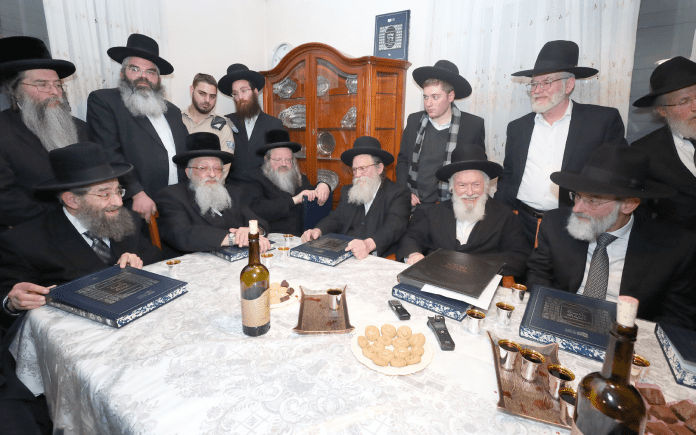Chaim Gold
(L-R) Harav Messod Ben Shimon, Harav Yaakov Meir Stern, HaRav Moshe Shaul Klein, Harav Sariel Rosenberg, Harav Yitzchok Zilberstein, and Rav Dovid Hofstedter.
Last month’s special gathering to celebrate the release of a new sefer was a historic occasion for the Jewish community.
The memorable gathering, hosted by Rav Yitzchok Zilberstein at his home, was a celebration of the release of the first volume of Dirshu’s groundbreaking Shulhan Aruch on the Yoreh Deah. The new sefer will undoubtedly have a transformative impact on the learning of Yoreh Deah.
World-Class Poskim
It is extremely rare to find so many of Eretz Yisrael’s most senior poskim under one roof, but a simha of such magnitude warranted such an august gathering.
Seated with the prominent posek, Rav Zilberstein were a number of other highly respected poskim from Bnei Brak, including Rav Moshe Shaul Klein, Rav Sariel Rosenberg, Rav Messoud Ben Shimon, Rav Yaakov Meir Stern, Rav Shevach Tzvi Rosenblatt, and Rav Shmuel Eliezer Stern, as well as Rav Dovid Hofstedter, the nasi of Dirshu.
Also attending the celebration was a large, distinguished group of great talmidei hachamim who were involved in the writing and editing the new publication. They were able to take the opportunity to get cogent advice and guidance on various matters pertaining to future volumes, which they are working on.
The Unique Components of Dirshu’s New Shulchan Aruch
More than a decade ago, Dirshu gifted the Torah world with the Dirshu Mishnah Berurah, a sefer that has become a classic. It was the first comprehensive sefer written alongside the Mishnah Berurah that brings the piskei halacha and additions of the various poskim in the more than 120 years since the Mishnah Berurah was originally published. It has become the go-to sefer for anyone looking up practical halacha on the Orach Chaim order of Shulchan Aruch, especially for areas of halacha involving the changes brought about by technology and day-to-day modern life.
There is no Mishnah Berurah on Yoreh Deah and, in general, to learn the Shulhan Aruch on the Yoreh Deah order of the Shulhan Aruch requires significant background.
Over the years, wonderful new editions of the Shulhan Aruch have been published with bold, large letters and numerous other enhancements, making it easier to learn. What Dirshu, however, has done with the release of the first volume of a planned nine-volume set on Yoreh Deah is truly innovative.
The beautiful Shulchan Aruch using the popular tzurat hadaf of Machon Yerushalayim’s edition has added two seminal commentaries on the corresponding page. The first commentary, entitled L’asukei Shemateta, explains the source in hazal for each halacha and then brings the sources for the psak from the Rishonim and Achronim, briefly explaining how the Rishonim understood the sugyot and determined their rulings.
The second, longer, commentary, entitled Alibah D’Hilchata, concisely encapsulates each halacha, adding halachic rulings from the Achronim and later poskim up to the present time on practical halachot, along with modern-day scenarios based on the original psak of the Shulhan Aruch and its meforshim.
In addition, Dirshu has included a comprehensive mafteiach (index) in the back, making it easy to find any halacha brought in that volume.
Dirshu chose to begin with the portion of the regular Shulchan Aruch that comprises the third and final volume of Yoreh Deah, simanim 270-361, which covers hilchot sefer Torah, mezuzah, shiluach hakein, chadash, orlah, kilayim, bechorot, bechor beheima, and petter chamor.
Highlighted Speakers
The event began with brief remarks by Rav Zilberstein. He quoted a Gemara from Gittin, “The world stands upon certain foundations – and who are those foundations? Those who teach halachot to the public!”
Rav Dovid Hofstedter followed Rav Zilberstein. He began, “This is a very emotional time. This edition of the Shulchan Aruch has been published after much thought and many nisyonos. Rav Hofstedter concluded the event by citing something he had heard from his rebbi, Rav Simcha Wasserman, zt”l. He asked, “What is the secret of the success of the Mishnah Berurah? So many other great, illustrious geonim wrote sefarim and they have almost been forgotten. The Mishnah Berurah and the Chofetz Chaim’s other sefarim only increased in popularity.
“The answer is that the Chofetz Chaim didn’t write sefarim to give over his own chiddushim. He wrote sefarim that were needed by Klal Yisrael. He was completely altruistic. Such sefarim, written solely for Klal Yisrael, are eternal.
“It is our fervent hope that this sefer that is so important for Klal Yisrael will serve a great purpose for Klal Yisrael, and will be successful in being mekadesh Shem Shamayim!”



